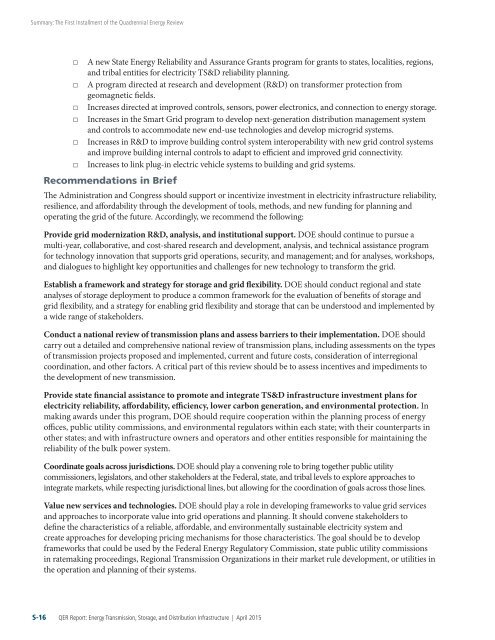LVXXU
LVXXU
LVXXU
You also want an ePaper? Increase the reach of your titles
YUMPU automatically turns print PDFs into web optimized ePapers that Google loves.
Summary: The First Installment of the Quadrennial Energy Review<br />
□□<br />
□□<br />
□□<br />
□□<br />
□□<br />
□□<br />
A new State Energy Reliability and Assurance Grants program for grants to states, localities, regions,<br />
and tribal entities for electricity TS&D reliability planning.<br />
A program directed at research and development (R&D) on transformer protection from<br />
geomagnetic fields.<br />
Increases directed at improved controls, sensors, power electronics, and connection to energy storage.<br />
Increases in the Smart Grid program to develop next-generation distribution management system<br />
and controls to accommodate new end-use technologies and develop microgrid systems.<br />
Increases in R&D to improve building control system interoperability with new grid control systems<br />
and improve building internal controls to adapt to efficient and improved grid connectivity.<br />
Increases to link plug-in electric vehicle systems to building and grid systems.<br />
Recommendations in Brief<br />
The Administration and Congress should support or incentivize investment in electricity infrastructure reliability,<br />
resilience, and affordability through the development of tools, methods, and new funding for planning and<br />
operating the grid of the future. Accordingly, we recommend the following:<br />
Provide grid modernization R&D, analysis, and institutional support. DOE should continue to pursue a<br />
multi-year, collaborative, and cost-shared research and development, analysis, and technical assistance program<br />
for technology innovation that supports grid operations, security, and management; and for analyses, workshops,<br />
and dialogues to highlight key opportunities and challenges for new technology to transform the grid.<br />
Establish a framework and strategy for storage and grid flexibility. DOE should conduct regional and state<br />
analyses of storage deployment to produce a common framework for the evaluation of benefits of storage and<br />
grid flexibility, and a strategy for enabling grid flexibility and storage that can be understood and implemented by<br />
a wide range of stakeholders.<br />
Conduct a national review of transmission plans and assess barriers to their implementation. DOE should<br />
carry out a detailed and comprehensive national review of transmission plans, including assessments on the types<br />
of transmission projects proposed and implemented, current and future costs, consideration of interregional<br />
coordination, and other factors. A critical part of this review should be to assess incentives and impediments to<br />
the development of new transmission.<br />
Provide state financial assistance to promote and integrate TS&D infrastructure investment plans for<br />
electricity reliability, affordability, efficiency, lower carbon generation, and environmental protection. In<br />
making awards under this program, DOE should require cooperation within the planning process of energy<br />
offices, public utility commissions, and environmental regulators within each state; with their counterparts in<br />
other states; and with infrastructure owners and operators and other entities responsible for maintaining the<br />
reliability of the bulk power system.<br />
Coordinate goals across jurisdictions. DOE should play a convening role to bring together public utility<br />
commissioners, legislators, and other stakeholders at the Federal, state, and tribal levels to explore approaches to<br />
integrate markets, while respecting jurisdictional lines, but allowing for the coordination of goals across those lines.<br />
Value new services and technologies. DOE should play a role in developing frameworks to value grid services<br />
and approaches to incorporate value into grid operations and planning. It should convene stakeholders to<br />
define the characteristics of a reliable, affordable, and environmentally sustainable electricity system and<br />
create approaches for developing pricing mechanisms for those characteristics. The goal should be to develop<br />
frameworks that could be used by the Federal Energy Regulatory Commission, state public utility commissions<br />
in ratemaking proceedings, Regional Transmission Organizations in their market rule development, or utilities in<br />
the operation and planning of their systems.<br />
S-16 QER Report: Energy Transmission, Storage, and Distribution Infrastructure | April 2015


